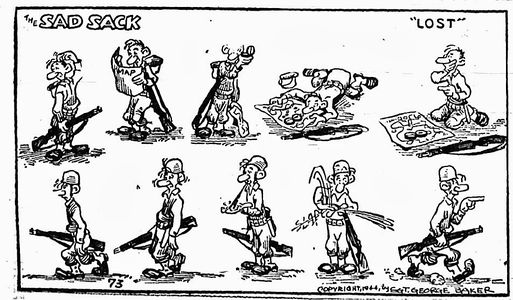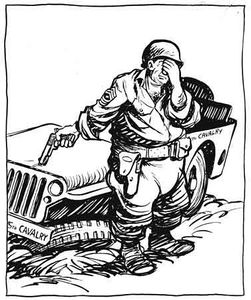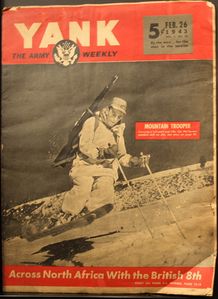Hartzell Spence
Click here for Pin-up girl page |
Click here for World War II History category page |
Hartzell Spence, 93, Dies; Pin-up Pioneer
- By DOUGLAS MARTIN
- Published: The New York Times
- May 25, 2001
Hartzell Spence, a writer who as founder and executive editor of Yank magazine during World War II helped introduce the term pinup, died on May 9 at his home in Essex, Conn. He was 93.
According to the Oxford English Dictionary, Yank was the first to use the term as a noun, in 1943, but Life magazine used pinup in 1941 as an adjective -- for a girl, of course.
The 2.2 million American soldiers who raptly awaited their weekly black-and-white glimpses of Rita Hayworth, Hedy Lamarr and other beauties wearing lingerie or swimsuits and come-hither expressions, are not known to have lingered over etymology.
But it seems certain that they valued Yank, which was written by, about and for the enlisted man, personified by its popular comic strip Sad Sack, which Mr. Spence also championed.
Yank's reporters were soldiers who carried both guns and notebooks into battle, and its cartoonists were of the caliber of Bill Keane, who went on to draw "The Family Circus," now appearing in 1,500 newspapers.
Gen. Dwight D. Eisenhower called Yank's staff highly professional, suggesting that few more important records of World War II can be found anywhere.
He did not mention the pinups, which found their way inside the lids of footlockers and were nailed to palm trees beside shaving mirrors; they lasted long after the rest of an issue was discarded. One 1944 pinup that proved worth keeping showed Norma Jean Baker, who became better known as Marilyn Monroe.
For these treats, soldiers could thank Mr. Spence, according to an account in "The Pin-up from 1852 to Now," a 1974 book by Ralph Stein, Yank's cartoon editor during the war.
Mr. Stein recalled an early staff meeting at the magazine, in which he quoted Mr. Spence as saying, We've got to have a pinup.
None of us had ever heard the term, Mr. Stein wrote. I think Hartzell might have invented it.
The pinup was not Mr. Spence's only addition to the national conversation. He heard about Sgt. George Baker, who had just won an Army cartoon contest, and asked him to send samples of his work. The result was Sad Sack, which vividly portrayed the soldier's existence and was widely syndicated after the war.
Mr. Spence was born on Feb. 15, 1908, in Clarion, Iowa. A Methodist minister's son, he graduated from the University of Iowa in 1930 as a member of Phi Beta Kappa, and then served as Iowa bureau manager of the United Press Association. He was promoted to New York to supervise the agency's special service bureau.
After having a dozen books rejected by publishers, he heeded a friend who had asked, Why don't you write something you know best about?
The result was One Foot in Heaven, a 1941 best seller about a Methodist minister's family as it moves from town to town. The plot has the congregation split into warring factions and depicts the choir as a cross between the devil's grandmother and a swarm of mountain wildcats.
After his service as editor of Yank, Mr. Spence was transferred to the Army Air Forces as special assistant to Gen. Lauris Norstad. He was awarded the Legion of Merit in 1945.
He then resumed his career as a writer of, among other things, historical novels and "The Big Top", written with Fred Bradna, a celebrated circus ringmaster. He wrote about 200 articles for magazines like "Saturday Evening Post", "Look" and "Reader's Digest".
In 1964, he wrote "Marcos of the Philippines," a biography of Ferdinand E. Marcos. The book, which described Marcos as having selfless, passionate patriotism, was distributed widely during Marcos's successful campaign for the presidency in 1965.
There were accusations that Mr. Spence either stretched the truth or was gullible. In 1986, "Newsweek magazine" published an article saying that wounds Mr. Spence reported Marcos as receiving in a single-handed battle against 50 Japanese were actually suffered at least a year earlier.
Mr. Spence is survived by a son, Matt L., of Boca Raton, Fla.; a daughter, Laurie Reeves of Lyme, Conn.; and two grandchildren.
His pinup idea almost ended up on the composing room floor, according to Mr. Stein's book. An early layout of the feature was sent to Henry L. Stimson, the secretary of war, who then sent it on to his superior officer, Mrs. Henry Stimson. She saw the pencil drawing and ordered it quashed.
But for reasons lost in time, the pinups -- as pictures and as nouns -- survived.
- Hartzell Spence appeared in YANK magazine on
Chat rooms • What links here • Copyright info • Contact information • Category:Root


